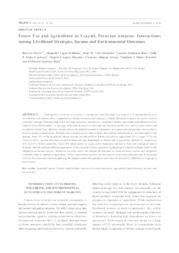Forest use and agriculture in Ucayali, Peruvian Amazon: interactions among livelihood strategies, income and environmental outcomes.
Forest use and agriculture in Ucayali, Peruvian Amazon: interactions among livelihood strategies, income and environmental outcomes.
Autoria: PORRO, R.; LOPEZ-FELDMAN, A.; VELA-ALVARADO, J. W.; QUIÑONEZ-RUÍZ, L.; SEIJAS-CARDENAS, Z. P.; VÁSQUEZ-MACEDO, M.; SALAZAR-ARISTA, C.; NÚÑEZ-PAREDES, V. I.; CARDENAS-RUIZ, J.
Resumo: Findings from a survey on sources of income and land allocation outcomes of 578 households from 26 communities with diverse ethnic composition at distinct environmental settings in Ucayali (Peruvian Amazon) are used to contrast livelihood strategies featuring high forest and high agriculture dependency, examining whether agricultural intensification can be linked to lower deforestation. A typology of households based on their land use allocation profile was used to assess current and cumulative cleared land. Recently cleared areas by households oriented to perennials, semi-perennials and pastures were similar to those focusing on annual crops. Multiple class comparisons provided evidence that land use intensification is not associated to land sparing. Near 40% of the households' annual income was derived from forests, followed by agriculture (25%), wages (17%) and livestock (11%). Income structure was used to determine high dependency on forests and on agriculture, featured by respectively 24% and 17% of the households, while 10% relied mostly on wages and/or businesses and half of them had a balanced income structure. Results indicate different expressions of the criticality of forest products, highlighting livelihood strategies based on the integration of income sources. Moreover, the study shows that despite the relevance of forest products, mestizo and indigenous livelihoods heavily depend on agriculture. Policy interventions aimed at environmental conservation and economic development will only be successful when strengthening the integration between agriculture and forest use featured by different social groups in the Amazon.
Ano de publicação: 2014
Tipo de publicação: Artigo de periódico
Unidade: Embrapa Amazônia Oriental
Palavras-chave: Agricultura, Agricultura intensiva, Amazônia peruana, Floresta, Pequeno agricultor, Uso
Observações
1 - Por padrão são exibidas publicações dos últimos 20 anos. Para encontrar publicações mais antigas, configure o filtro ano de publicação, colocando o ano a partir do qual você deseja encontrar publicações. O filtro está na coluna da esquerda na busca acima.
2 - Para ler algumas publicações da Embrapa (apenas as que estão em formato ePub), é necessário ter, no celular ou computador, um desses softwares gratuitos. Sistemas Android: Google Play Livros; IOS: iBooks; Windows e Linux: software Calibre.
Acesse outras publicações
Acesse a Base de Dados da Pesquisa Agropecuária (BDPA) para consultar o acervo completo das bibliotecas da Embrapa.

